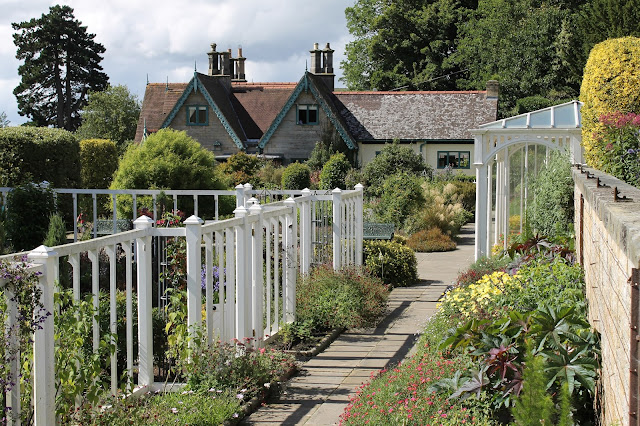Cragside is a huge estate so
it's not surprising there are many parts of it I have not seen before
our most recent visit. When we first visited Cragside many years ago
the Iron Bridge was out of bounds for the public to cross so we
never went to that part of the estate. On more recent visits we have
headed straight from the house and done the six mile estate drive. In
last week's post on The
Rock Garden I left you with a teaser on what laid beyond the main
house and what a surprise I had.
Once you cross over the
Debdon Burn the footpath leads you up and through the pine trees.
Once you reach the top the tree line finishes and there's a gate
inviting you to go through but comes with a request to close it so to
stop the rabbits getting. Any rabbits that do break in must be in for
a feast. Beyond the gate lies The Formal Garden.
William Armstrong bought
this vast section of land near Rothbury in Northumberland in the
1860s. He set upon building a fine family home the other side of the
estate's valley. This part of Cragside was
always in the original estate that Armstrong purchased. You
would think the views out to the moors and beyond would be sufficient
for most people to admire but Armstrong was never one for letting
things stand still.
The slope was a feature of
this stretch of land but Armstrong transformed the small field into a
formal garden on with terracing on three different levels.
One of the most dominate
features of the garden is the border planting. Each year a different
design is used and this year over 25,000 plants have been used. The
inspiration for this year's design comes from a photograph of the
carpet border taken in 1900.
Rising up behind the border
is The Clock Tower. It is styled more like a chapel with hints of
Gothic revival but when it was built in the late 1860s it was always
meant for more practical and administrative purposes. The clock
served as the estate time piece and the bell in the belfy rang to
signify the start and finish of work shifts plus meal times. The
building was used as the pay office.
A glasshouse would have been
an essential in most Victorian gardens but especially here in the
remote Northumbrian hills. The shelter provided by this structure
allows not only domestic varieties to thrive but also fruits liking
warmer climes such as grapes, lemons and oranges.
This glasshouse is
known as the orchard house and is one of the oldest surviving from
the 1870s. The National Trust restored parts of it in the 1990s. All
the trees grown in it though are varieties which date from when it
was originally constructed.
The picture perfect cottage
was built around 1865 for the estate manager. Further building work
in the 1890s added an extension which was then used as an estate
office. If this looks like your dream house to live you can try it
out for a few days as the National Trust now rents it out as a
holiday let named Garden
Cottage.
There are few gardens of
this style which wouldn't be complete without a rose garden. Last
year a new rose bed was dug and around 300 rose plants were put it.
Despite the lateness of the season the white roses were still showing
a glorious display.
In recent years the lowest
level of the terracing known as the Italian terrace has had a large
amount of work done on it. The Loggia dating from 1870 is still in
place as a fine example of Armstrong's design skills. It is thought
that the cast iron structure was made at Armstrong's Elswick works.
The top and two sides has glass in them but the front is completed
open.
Also on this level an opened walled garden accessible
through a door. The walls as such are white poles which gives the
feeling of looking in from outside. Whatever you do when you visit
Cragside don't forget to make your way up to the Formal Garden to
have a look inside.
 |
| Hosted by Mammasaurus |













I have such a soft spot for Victorian planting with its carpet planting display and the glasshouses are just beautiful. Great insight into this garden.
ReplyDeleteWow what a border! I can't help but be impressed with the use of 25,000 plants in one design - such planning and attention to detail. That glasshouse and clocktower are something else. Ah it all looks great - I wish I lived closer!
ReplyDeleteThank you for sharing and joining in again, you always show me somewhere new!
As you know I was very excited to read last time about Craigside. Now I need to find out about the Garden Cottage - it would be so cool to stay there and explore.
ReplyDeletewow wow wow are you ever going to run out of blog posts with this marvellous house and garden. i really love the patterns and colour in the borders
ReplyDeleteI like the story behind the border - I'm always amazed at how accurate the gardeners are when they plant these border arrangements. Makes my 'planned planting' look a bit slapdash :)
ReplyDeleteA lovely history lesson on such a stunning garden, the plant border is stunning. The glasshouses are dreamy, would love the room for just a tiny one of those
ReplyDeleteIt looks a lovely place - and wouldn't it be lovely to have a glasshouse like that in our own gardens? :) #hdygg
ReplyDeleteAhhhh - a National Trust garden. Lovely and one of just a very few things I do miss about not living in the UK. But I'll be back for a trip soon and garden visits are planned.
ReplyDelete